While heatproof gloves designed specifically for grilling may seem like overkill, we recommend them for novice and pro barbecuers alike. The best gloves protect your hands and forearms while you’re standing at a grill and maneuvering hot tools, grates, and food. The WZQH Leather Forge Welding Gloves are our top recommendation for most people. They come in a range of sizes and provide excellent heat protection without limiting dexterity. Their suede exterior is slightly difficult to clean, so if you’re going to be directly touching messy food, we recommend the Kitchen Perfection Silicone Smoker Oven Gloves instead. These cotton-lined silicone gloves don’t cover forearms, but they fend off heat extremely well. They also rinse clean in a snap.
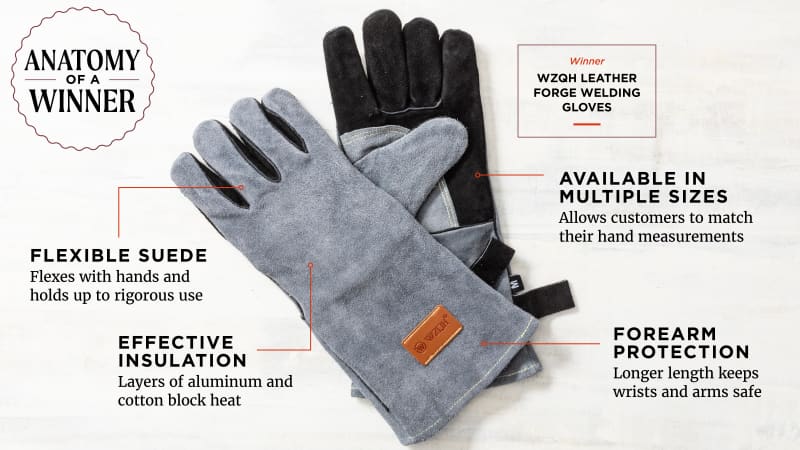
Grill gloves (also called “barbecue gloves” or “BBQ gloves”) are designed to protect your hands and forearms from heat while you’re cooking or moving tools and grates over hot coals or open flames. Their outer layers are usually made from one or a few types of heat-resistant materials, including suede, silicone, or “aramids” (short for “aromatic polyamides”). Aramids are a category of durable polymers that can be fashioned into fibers for use in several industrial applications, including constructing ship hulls and making Kevlar body armor. The type of aramid fibers used for grill gloves are adept at blocking heat. Most gloves are lined with cotton for comfort, but some gloves are unlined.


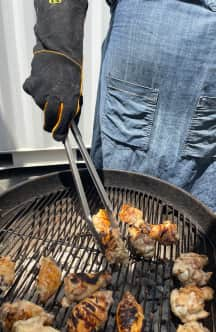
We put the grill gloves through a litany of tests designed to assess their fit, comfort, flexibility, and heat protection. Testers of multiple hand sizes weighed in on whether the gloves helped or hindered their ability to handle food efficiently and safely.
While grill gloves may not seem essential, they are extremely helpful for outdoor cooking—especially grilling with charcoal or burning wood in a fire pit. They can keep you safe when pouring flaming coals out of a chimney starter or adjusting logs for an open-fire grilling session. We find them indispensable for these tasks and useful when cooking a simple dinner over a gas grill too. We tested gloves made from all sorts of materials in several sizes to find which factors set the best pairs apart.
What to Look For
- Multiple Sizes: Hand sizes vary, and manufacturers who claim their gloves “fit all” users are simply lying. We much preferred gloves that were tailored to our respective hand sizes, with multiple options to choose from. For example, our winning gloves are available in four sizes with an online measurement guide that made it easy for each of us to find the pair that worked best.
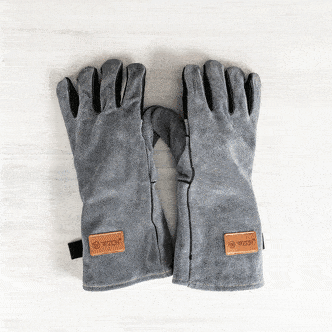

We preferred gloves that were well-proportioned, with palms and fingers that fit us securely (left) and offered multiple sizes to choose from. Many gloves (right) had excess fabric in the fingers, which felt clumsy and kept us from gripping tongs or food with precision.
- Well-Proportioned Designs: Beyond overall sizing, it was also important that gloves matched the relative proportions of human hands (shocking, we know). The best gloves fit a majority of testers properly, with finger sizes that complemented palm sizes. This ensured that no one part of the gloves was disproportionately larger or smaller than the others.
- Relatively Thick, Heatproof Fabrics: The right combination of materials made some gloves more heat protective than others. Suede and silicone were usually best. The top-performing gloves also added layers of flame-retardant cotton and air-isolated aluminum foil. This foil reflects radiant heat and is surrounded by an airless pocket (similar to the airless gap in a thermos) to prevent further heat conduction. These layers effectively blocked heat transmission and kept us cool even when we touched scorching metal. The gloves made with these additional materials were a bit thicker, which felt more protective.
- Sturdy Yet Flexible Materials: We prized gloves that were sturdy enough to protect us but flexible enough to bend and fold with our hands. Our favorites struck a good balance by simultaneously blocking heat and flexing as needed. This maintained our dexterity and made everything easier (and safer).
- Comfortable Linings: The best gloves were lined with comfortable cotton, which helped absorb sweat and made it easy to don and shed the gloves quickly.
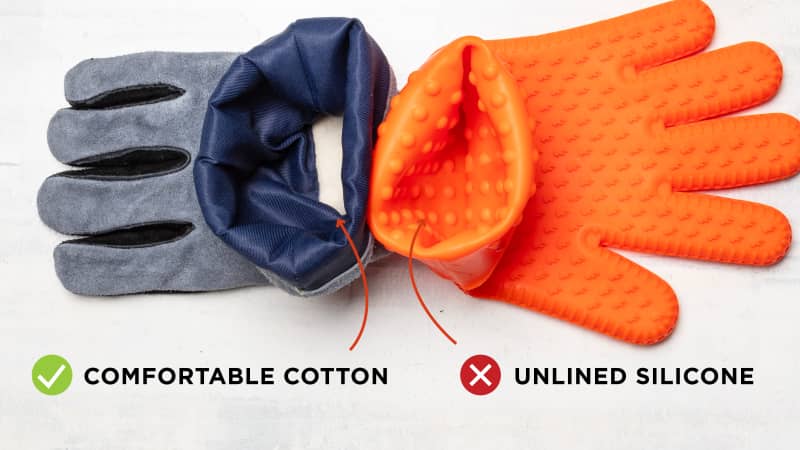
Nice to Have
- Forearm Protection: If you frequently use a charcoal grill or burn wood logs to grill in a fire pit, we think it’s best to choose gloves that will protect your forearms. Pouring burning coals out of a chimney starter, adjusting scorching grill grates, and repositioning food are all rendered safer by wearing gloves that extend well past your wrists. Longer gloves will also protect you when you’re reaching into grills or pits to rearrange hot coals, even if you use grill tongs (which we also recommend).
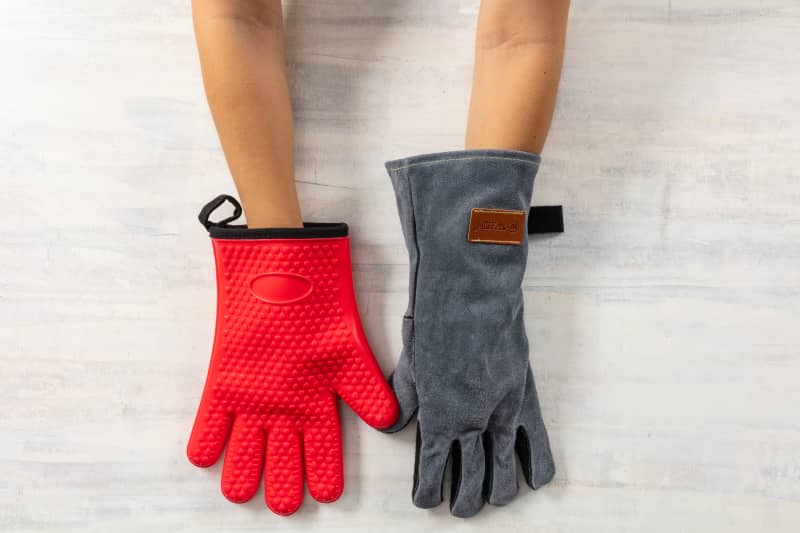
- Easy-to-Clean Exteriors: Our winning gloves provide excellent heat protection, but their suede exterior wasn’t the easiest to clean. If you plan on using grill gloves to directly handle heavy, messy food such as barbecue brisket or ribs, it’s best to buy silicone gloves like our runner-up. They won’t stain, and they rinse clean and wipe dry without fuss.
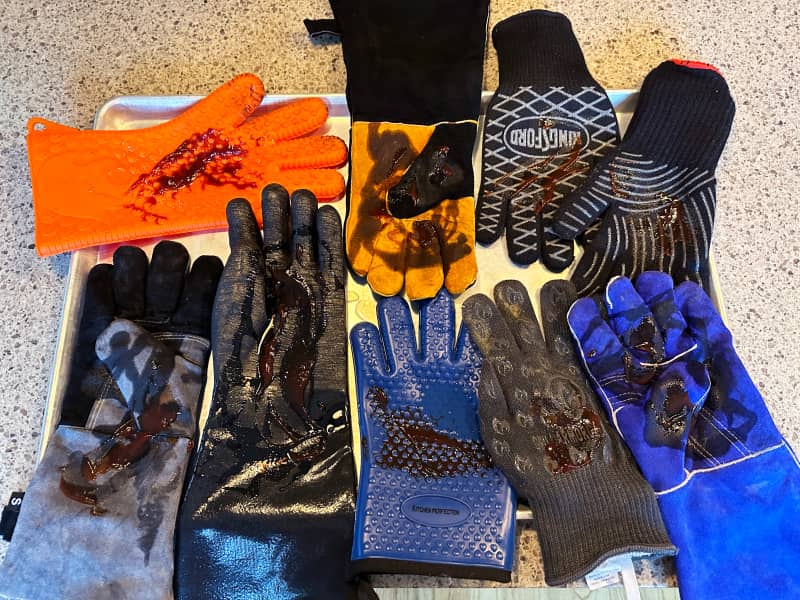
What to Avoid
- One-Size-Fits-All Designs: One size decidedly doesn’t fit all. Squeezing our palms through too-small wrist openings or contending with bulbous extra fabric in the fingertips was irritating, and it slowed us down. Buying the wrong size gloves is a waste of money; if they don’t fit you, you won’t want to wear them. Opt for gloves available in multiple sizes so that you can purchase what’s best for you.
- Inaccurate Proportions: Worse yet, a few gloves we tested were too small in some areas and simultaneously too large in others.

Some gloves fit most testers poorly, coating their hands in excess fabric that got in the way of cooking. We liked gloves available in multiple sizes that felt tailored to fit us, without overly long finger panels.
- Thin, Nonprotective Fabrics: Some gloves were simply too thin to take the heat. Despite being made with heatproof aramid fibers, some knit-style gloves felt too flimsy and uninsulated, and we felt unsafe while wearing them during most of our tests, including pouring hot charcoal and grilling over open flames.
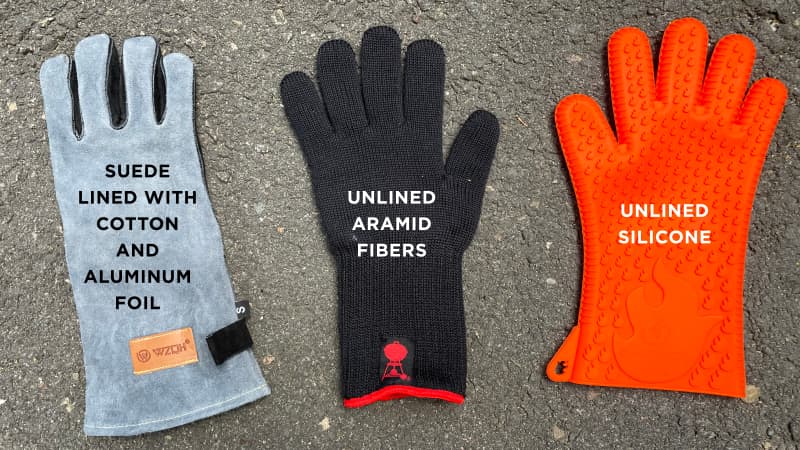
- Thick, Rigid Materials: One set of gloves had a thick neoprene exterior that was easy to clean but extremely rigid and rubbery. This stiffness markedly limited our dexterity.
- Unlined Gloves: Unlined aramid-fiber gloves felt scratchy, and unlined silicone gloves felt like we were putting our hands into giant suction cups. Sweat from the hot flames and summer weather made this discomfort even worse. The lack of linings made these sets of gloves much harder to put on and take off.
Other Considerations
- Durability: Grill gloves are made to withstand tough use and scorching temperatures. They will inevitably show signs of wear over time, but you can make them last longer if you clean them according to manufacturer instructions a couple of times during each grilling season. Try not to leave them out in the rain, since moisture can make some gloves less protective. And don’t stress over small stains and scorch marks—treat them as badges of honor depicting successful past barbecue sessions.
The Tests
- Heat a cast-iron skillet until the handle registers 350 degrees and then time how long we can comfortably grip the skillet’s handle
- Heat a chimney starter full of charcoal briquettes and then grasp the chimney handle while pouring burning briquettes into a charcoal grill
- Arrange hot charcoal with grill tongs and then position a grill grate over the coals
- Arrange and grill sliced zucchini on a hot charcoal grill using grill tongs
- Cook Grill-Roasted Chicken and Ember Baked Potatoes over a fire pit, using gloves to reposition the burning logs and embers and hot grill grates, as well as the potatoes and chicken
- Stain gloves with 1 tablespoon of barbecue sauce and 1 tablespoon of vegetable oil, set aside for 4 hours, and then clean five times according to manufacturer instructions
- At the end of testing, heat a cast-iron skillet until the handle registers 350 degrees and then time how long we can comfortably grip the skillet’s handle, noting any changes from the initial test
How We Rated
- Fit/Comfort: We evaluated how well the gloves fit testers with hands and arms of many different sizes. We also noted whether the linings were comfortable.
- Heat Protection: We rated how well the gloves protected our hands while directly touching hot objects and being near sources of radiant heat.
- Dexterity: We determined whether the gloves’ materials and bulk hindered our ability to accomplish common grilling tasks.
- Cleanup/Durability: We evaluated whether the gloves were easy to clean and noted if they retained stains and odors. We also assessed whether the gloves held up to rigorous use over time.















